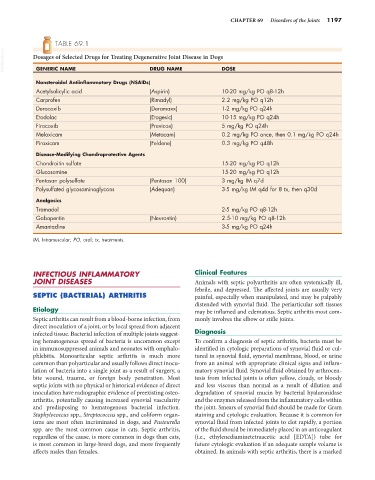Page 1225 - Small Animal Internal Medicine, 6th Edition
P. 1225
CHAPTER 69 Disorders of the Joints 1197
TABLE 69.1
VetBooks.ir Dosages of Selected Drugs for Treating Degenerative Joint Disease in Dogs DOSE
GENERIC NAME
DRUG NAME
Nonsteroidal Antiinflammatory Drugs (NSAIDs)
Acetylsalicylic acid (Aspirin) 10-20 mg/kg PO q8-12h
Carprofen (Rimadyl) 2.2 mg/kg PO q12h
Deracoxib (Deramaxx) 1-2 mg/kg PO q24h
Etodolac (Etogesic) 10-15 mg/kg PO q24h
Firocoxib (Previcox) 5 mg/kg PO q24h
Meloxicam (Metacam) 0.2 mg/kg PO once, then 0.1 mg/kg PO q24h
Piroxicam (Feldene) 0.3 mg/kg PO q48h
Disease-Modifying Chondroprotective Agents
Chondroitin sulfate 15-20 mg/kg PO q12h
Glucosamine 15-20 mg/kg PO q12h
Pentosan polysulfate (Pentosan 100) 3 mg/kg IM q7d
Polysulfated glycosaminoglycans (Adequan) 3-5 mg/kg IM q4d for 8 tx, then q30d
Analgesics
Tramadol 2-5 mg/kg PO q8-12h
Gabapentin (Neurontin) 2.5-10 mg/kg PO q8-12h
Amantadine 3-5 mg/kg PO q24h
IM, Intramuscular; PO, oral; tx, treatments.
INFECTIOUS INFLAMMATORY Clinical Features
JOINT DISEASES Animals with septic polyarthritis are often systemically ill,
febrile, and depressed. The affected joints are usually very
SEPTIC (BACTERIAL) ARTHRITIS painful, especially when manipulated, and may be palpably
distended with synovial fluid. The periarticular soft tissues
Etiology may be inflamed and edematous. Septic arthritis most com-
Septic arthritis can result from a blood-borne infection, from monly involves the elbow or stifle joints.
direct inoculation of a joint, or by local spread from adjacent
infected tissue. Bacterial infection of multiple joints suggest- Diagnosis
ing hematogenous spread of bacteria is uncommon except To confirm a diagnosis of septic arthritis, bacteria must be
in immunosuppressed animals and neonates with omphalo- identified in cytologic preparations of synovial fluid or cul-
phlebitis. Monoarticular septic arthritis is much more tured in synovial fluid, synovial membrane, blood, or urine
common than polyarticular and usually follows direct inocu- from an animal with appropriate clinical signs and inflam-
lation of bacteria into a single joint as a result of surgery, a matory synovial fluid. Synovial fluid obtained by arthrocen-
bite wound, trauma, or foreign body penetration. Most tesis from infected joints is often yellow, cloudy, or bloody
septic joints with no physical or historical evidence of direct and less viscous than normal as a result of dilution and
inoculation have radiographic evidence of preexisting osteo- degradation of synovial mucin by bacterial hyaluronidase
arthritis, potentially causing increased synovial vascularity and the enzymes released from the inflammatory cells within
and predisposing to hematogenous bacterial infection. the joint. Smears of synovial fluid should be made for Gram
Staphylococcus spp., Streptococcus spp., and coliform organ- staining and cytologic evaluation. Because it is common for
isms are most often incriminated in dogs, and Pasteurella synovial fluid from infected joints to clot rapidly, a portion
spp. are the most common cause in cats. Septic arthritis, of the fluid should be immediately placed in an anticoagulant
regardless of the cause, is more common in dogs than cats, (i.e., ethylenediaminetetraacetic acid [EDTA]) tube for
is most common in large-breed dogs, and more frequently future cytologic evaluation if an adequate sample volume is
affects males than females. obtained. In animals with septic arthritis, there is a marked

